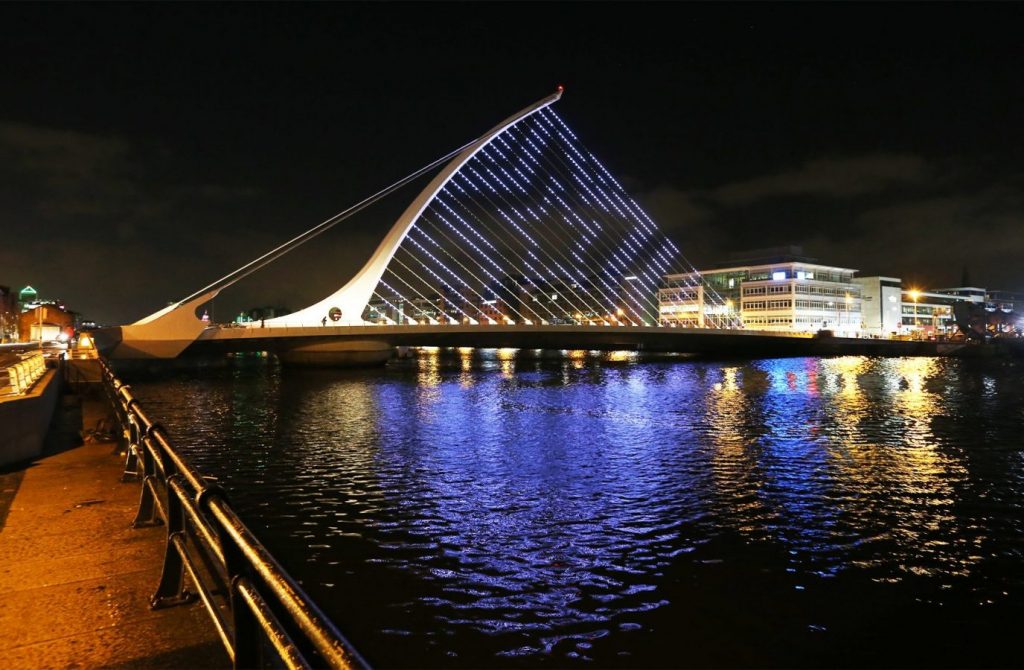Cuts to lighting hours and use of HVO generators part of efforts to reduce costs and carbon output of displays.
Waste vegetable oil generators, reduced operating hours and a light display with all the power of a vacuum cleaner may not sing “It’s Christmas!” but are all part of an effort to make this festive season in Dublin greener and cheaper.
The four Dublin local authorities plan to make efforts this year to reduce the costs and carbon output of their Christmas displays. In some cases, this means the lights will be on for shorter durations, but in others, technology will be used to keep Christmas cheery in the face of soaring energy costs.
Dublin City Council’s Winter Lights initiative, which sees light projects on the outside of a number of public buildings and bridges, will be operated using generators filled with hydrotreated vegetable oil (HVO), which the council said is “made from 100 per cent renewable waste materials”.
[ Dublin’s winter lights shine with low-energy batteries ]
Using vegetable oil results in a 90 per cent reduction in CO2 emissions when compared with diesel and a 30 per cent reduction in nitrogen oxide emissions. The oil is biodegradable in fewer than 60 days and, unlike diesel, has no smell “so is ideal for use in generators at events”, the council said.
“Where it is not possible to use HVO generators at a particular location, localised battery storage power will be used. The battery packs will charge during offpeak hours and the stored energy from the batteries will be used during peak hours to power projectors and installations, thus eliminating any additional draw on the grid during peak periods,” it said.
The council last year introduced laser technology for its illuminations in Smithfield Square, which used “the equivalent of a standard domestic socket”. Previously, illuminating the Custom House had taken 40kW of power, this has been reduced to 12kW with LEDs, while the lights on the Samuel Beckett Bridge use just 2kW of power, “the equivalent of [a] vacuum cleaner”, the council said.
In Dún Laoghaire-Rathdown, the council will be running its displays on timers “to restrict illumination times to approximately seven hours per day”, a spokesman said. “In previous years these displays would have been lit from dusk to dawn in line with street light operation.”
[ Tesco’s weird take on Irishness, Boots’ night-bus terror: The Christmas TV ads, 2022 ]
The illuminated forest walks at Marlay Park and Cabinteely Park “are environmentally friendly”, the council said, and “where possible, all official Dún Laoghaire-Rathdown County Council Christmas trees are living trees and their lights are LED extra-low voltage for safety, only using on average 4.8 watts of electricity”.
The towns and villages in the Dún Laoghaire-Rathdown area are “dressed by local business and community groups” with funding support from the council. “For 2022, all organisations have been asked to achieve a 10 per cent to 15 per cent ‘Reduce Your Use’ target through shorter hours or fewer days of illumination.”
The council said it cannot identify the costs of running its Christmas lights as they are powered through connections to the street light network and “so energy costs are not identifiable separately”.
Fingal County Council said despite plans to restrict lighting hours it expects to face higher power bills this year.
“We illuminate 10 historical/community facilities across Fingal for six weeks and also 42 Christmas trees,” a spokeswoman said. “We are reducing the lighting-up hours, saving 840 hours over the six weeks.”
[ Ice-skating rink at Dundrum Town Centre gets green light for Christmas ]
Despite the reduced hours of operation, the cost of the displays at the 10 buildings is expected to rise by more than 40 per cent this year, from €14,000 to about €20,000.
The Christmas trees, which use LED bulbs, represent a more modest outlay. They will be lit from 4pm to 11pm with the total number of hours reduced from 1,440 hours last year to 360 this year, with an expected total cost of €190.
South Dublin County Council will light two trees this year at County Hall in Tallaght and the civic offices in Clondalkin. These will be connected to the buildings’ ESB supply and the cost “is considered minimal”, the council said.
Christmas lights in the county’s villages and urban areas are provided directly by local businesses and community groups with some funding from the council. “Once in place, the council supports the electricity connection of these lights, which typically run from 4pm to 1am. These lights are LED and the cost of running them is small,” it said.
Author Olivia Kelly
www.Irishtimes.com
